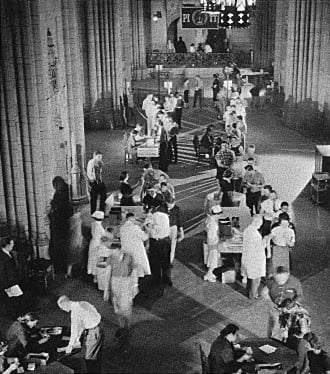*Image Credit: Wikimedia Commons In the history of mankind, few diseases have caused more damage in the lives of young children than poliomyelitis. The crippling condition, caused by a virus entering the central nervous system, finally met its match when Jonas Salk received approval for a vaccine on April 12, 1955. In the decades since, worldwide cases have been to reduced to a microscopic percentage compared to the numbers experienced in the first half of the 20th century. Polio is a highly infectious disease that, for the most part, results in no symptoms whatsoever — less than 1 per cent of cases turn into the devastating paralysis most people associate with the virus. Generally speaking, the contagion enters an individual orally, resting in the back of the throat or the intestines. Once there, the person’s immune system will usually seize on the invading organism and help the body develop a defense against it. Children, who naturally have weaker immune responses, are therefore especially susceptible to infection. Problems occur in about 1 out of every 10 instances, when the virus finds a way to slide into the bloodstream. From there, polio gains access to the brain and spinal cord, giving it the opportunity to damage tissue. Even then, the symptoms are often more along the lines of acute influenza — high fever, fatigue, a sore throat, vomiting — meaning the illness passes without arousing too much suspicion. In about 0.5 per cent of patients, the brain or spinal cord are affected, leaving the individual with paralysis that varies based upon the structures involved. This can result in a paralyzed leg or arm or, in very rare instances, seizures, difficulty breathing and visual disturbances. For parents, the disease can be a nightmare: a once-healthy child can soon require special care in a matter of days or weeks. After a mild expansion in the number of reported cases during the late 1800s, infection rates exploded in the first decade of the 1900s. Each summer, parents would be cautioned against “polio season,” as playing children would come into contact with one another more frequently. Eager to find a cure, researchers engaged in a “Great Race” to discover a solution to the problem. The first attempt arrived in 1936, when Maurice Brodie introduced a neutralized virus into a number of test subjects at New York University. It failed miserably, creating no immunity in the patients and causing allergic reactions in many. It would be another eight years before scientists made a breakthrough, when a team at Children’s Hospital Boston induced the growth of poliovirus in culture, which gave John Enders, Thomas H. Weller and Frederick C. Robbins the Nobel Prize in Physiology or Medicine for 1954. At the time, there were tens of thousands of new cases being reported each year in the United States alone, including a major spike in 1952-53. Working at the University of Pittsburgh, Salk managed to distill an effective vaccine just as the outbreak worsened, completing a successful trial in March 1953. Determined to quell a rush on his product, he took to the radio to explain the necessity of further testing in order to receive approval. Almost a year after seeing his research published in the Journal of the American Medical Association, Salk began wider tests in Pittsburgh before moving on to further study in 44 states from coast to coast. On April 12, 1955, the final observations were made public: Salk’s vaccine was, at minimum, 60 per cent effective. To many, the findings were considered nothing short of a miracle. Within weeks, Salk licensed the formula to pharmaceutical companies. By the fall of 1955, vaccination programs were in place across the country, headed by the March of Dimes. In 1957, two short years after the vaccine was approved, the number of reported cases dropped to 5,600 from 35,000 in 1953. In 1961, there were only 161 instances of polio nationwide. Since the early 1960s, the vaccine has existed in two forms — one delivered via injection and the other an oral dose administered in drops. The availability and ease of treatment allowed many industrialized countries to drastically reduce the occurrence of polio in just a matter of years, though the illness continued to ravage third world nations into the 1990s. In the last 20 years, however, the help of non-governmental organizations has allowed both forms of the vaccine to reach far into impoverished nations. As of 2007, there were just 1,652 cases of polio across the globe, down from as many as 350,000 in 1988. Also On This Day: 1204 – Knights from western Europe enter Constantinople, bringing the Fourth Crusade to an end 1861 – The American Civil War begins when the first shots are fired at Fort Sumter by Confederate forces in the harbor of Charleston, South Carolina 1945 – President of the United States Franklin D. Roosevelt dies in office, making Harry Truman the 33rd President 1961 – Soviet Cosmonaut Yuri Gagarin becomes the first man in space as part of the first manned orbital flight, Vostok 1 1981 – The first Space Shuttle launch, Columbia, occurs at Cape Canaveral
April 12 1955 – The Polio Vaccine is Declared Safe and Effective
*Image Credit: Wikimedia Commons In the history of mankind, few diseases have caused more damage in the lives of young children than poliomyelitis. The crippling condition, caused by a virus…
384
